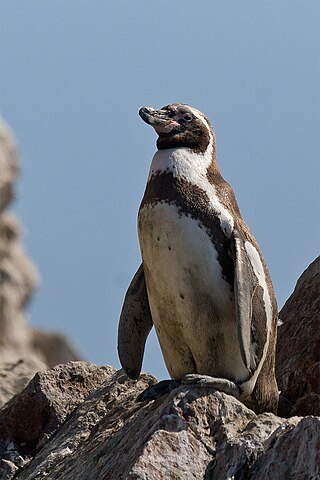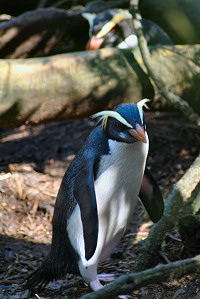
The little penguin is the smallest species of penguin. It originates from New Zealand. It is commonly known as the fairy penguin, little blue penguin, or blue penguin, owing to its slate-blue plumage and is also known by its Māori name kororā. It is a fossorial bird.

The killdeer is a large plover found in the Americas. It gets its name from its shrill, two-syllable call, which is often heard. It was described and given its current scientific name in 1758 by Carl Linnaeus in the 10th edition of his Systema Naturae. Three subspecies are described. Its upperparts are mostly brown with rufous fringes, the head has patches of white and black, and two black bands cross the breast. The belly and the rest of the breast are white. The nominate subspecies breeds from southeastern Alaska and southern Canada to Mexico. It is seen year-round in the southern half of its breeding range; the subspecies C. v. ternominatus is resident in the West Indies, and C. v. peruvianus inhabits Peru and surrounding South American countries throughout the year. North American breeders winter from their resident range south to Central America, the West Indies, and the northernmost portions of South America. Despite their name, they are not known for killing deer.

The American coot, also known as a mud hen or pouldeau, is a bird of the family Rallidae. Though commonly mistaken for ducks, American coots are only distantly related to ducks, belonging to a separate order. Unlike the webbed feet of ducks, coots have broad, lobed scales on their lower legs and toes that fold back with each step to facilitate walking on dry land. Coots live near water, typically inhabiting wetlands and open water bodies in North America. Groups of coots are called covers or rafts. The oldest known coot lived to be 22 years old.

The southern rockhopper penguin is a species of rockhopper penguin, that is sometimes considered distinct from the northern rockhopper penguin. It occurs in subantarctic waters of the western Pacific and Indian Oceans, as well as around the southern coasts of South America.

The macaroni penguin is a species of penguin found from the Subantarctic to the Antarctic Peninsula. One of six species of crested penguin, it is very closely related to the royal penguin, and some authorities consider the two to be a single species. It bears a distinctive yellow crest on its forehead. Its face and upperparts are black and sharply delineated from the white underparts. Adults weigh on average 5.5 kg (12 lb) and are 70 cm (28 in) in length. The male and female are similar in appearance; the male is slightly larger and stronger with a relatively larger bill. Like all penguins, it is flightless, with a streamlined body and wings stiffened and flattened into flippers for a marine lifestyle.

The yellow-eyed penguin, known also as hoiho, is a species of penguin endemic to New Zealand. It is the sole extant species in the genus Megadyptes.

The erect-crested penguin is a penguin endemic to the New Zealand region and only breeds on the Bounty and Antipodes Islands. It has black upper parts, white underparts and a yellow eye stripe and crest. It spends the winter at sea and little is known about its biology and breeding habits. Populations are believed to have declined during the last few decades of the twentieth century, and the International Union for Conservation of Nature has listed it as being "endangered".

The Humboldt penguin is a medium-sized penguin. It resides in South America, along the Pacific coast of Peru and Chile. Its nearest relatives are the African penguin, the Magellanic penguin and the Galápagos penguin. The Humboldt penguin and the cold water current it swims in both are named after the explorer Alexander von Humboldt. The species is listed as vulnerable by the IUCN with no population recovery plan in place. The current wild population is composed of roughly 23,800 mature individuals and is declining. It is a migrant species.

The Snares penguin, also known as the Snares crested penguin and the Snares Islands penguin, is a penguin from New Zealand. The species breeds on the Snares Islands, a group of islands off the southern coast of the South Island. It is a yellow-crested penguin, with a size of 50–70 cm (19.5–27.5 in) and a weight of 2.5–4 kg (5.5–8.8 lb). It has dark blue-black upper parts and white underparts. It has a bright yellow eyebrow-stripe which extends over the eye to form a drooping, bushy crest. It has bare pink skin at the base of its large red-brown bill.

The blue-footed booby is a marine bird native to subtropical and tropical regions of the eastern Pacific Ocean. It is one of six species of the genus Sula – known as boobies. It is easily recognizable by its distinctive bright blue feet, which is a sexually selected trait and a product of their diet. Males display their feet in an elaborate mating ritual by lifting them up and down while strutting before the female. The female is slightly larger than the male and can measure up to 90 cm (35 in) long with a wingspan up to 1.5 m (5 ft).

Eudyptes is a genus of penguins whose members are collectively called crested penguins. The exact number of species in the genus varies between four and seven depending on the authority, and a Chatham Islands species became extinct in recent centuries. All are black and white penguins with yellow crests, red bills and eyes, and are found on Subantarctic islands in the world's southern oceans. All lay two eggs, but raise only one young per breeding season; the first egg laid is substantially smaller than the second.

The rockhopper penguins are three closely related taxa of crested penguins that have been traditionally treated as a single species and are sometimes split into three species.

The mottled petrel or kōrure is a species of seabird and a member of the gadfly petrels. It usually attains 33 to 35 cm (13–14 in) in length with a 74 to 82 cm (29–32 in) wingspan.

The fairy tern is a small tern which is native to the southwestern Pacific. It is listed as "Vulnerable" by the IUCN and the New Zealand subspecies is "Critically Endangered". Fairy terns live in colonies along the coastlines and estuaries of Australia, New Zealand, and New Caledonia, feeding largely on small, epipelagic schooling fishes, breeding in areas close to their feeding sites. They have a monogamous mating system, forming breeding pairs in which they mate, nest, and care for offspring.

The Chatham penguin, also known as the Chatham crested penguin, Chatham Islands penguin, or Warham's penguin, is an extinct species of crested penguin previously endemic to the Chatham Islands of New Zealand. It is known only from subfossil bones and probably became extinct within 150–200 years after Polynesians arrived in the Chatham Islands around 1500 CE.

The northern rockhopper penguin, Moseley's rockhopper penguin, or Moseley's penguin is a penguin species native to the southern Indian and Atlantic Oceans. It is described as distinct from the southern rockhopper penguin.

The eastern rockhopper penguin, also known as the tawaki piki toka, is a crested penguin with yellow crest feathers. It is a subspecies of the southern rockhopper penguin found in subantarctic regions and the Indian Ocean. It is one of the smallest crested penguins and has distinctive pink margins around its bill.

The term seabird is used for many families of birds in several orders that spend the majority of their lives at sea. Seabirds make up some, if not all, of the families in the following orders: Procellariiformes, Sphenisciformes, Pelecaniformes, and Charadriiformes. Many seabirds remain at sea for several consecutive years at a time, without ever seeing land. Breeding is the central purpose for seabirds to visit land. The breeding period is usually extremely protracted in many seabirds and may last over a year in some of the larger albatrosses; this is in stark contrast with passerine birds. Seabirds nest in single or mixed-species colonies of varying densities, mainly on offshore islands devoid of terrestrial predators. However, seabirds exhibit many unusual breeding behaviors during all stages of the reproductive cycle that are not extensively reported outside of the primary scientific literature.

Giselle Clarkson is a New Zealand cartoonist and illustrator, best known for her non-fiction comics on conservation and environmental issues.























